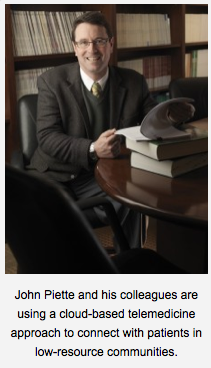We needn’t read another market forecast or research report to know: Cloud computing is poised to help revolutionize nearly every aspect of modern healthcare. Likewise, we don’t have to dip into our RSS feeds to realize significant challenges to broad adoption of cloud within the sector remain — not least of which are regulatory hurdles and security concerns.
We needn’t read another market forecast or research report to know: Cloud computing is poised to help revolutionize nearly every aspect of modern healthcare. Likewise, we don’t have to dip into our RSS feeds to realize significant challenges to broad adoption of cloud within the sector remain — not least of which are regulatory hurdles and security concerns.
But while its widespread application has yet to be seen, it’s important to consider how cloud is already making a difference at a much smaller, more personal scale — by improving the lives of patients in need.
For physicians treating those with chronic conditions like hypertension or diabetes, it can be tough enough getting patients into their offices for scheduled visits, let alone convincing them to keep up with plans to manage their health at home. Research has shown that inadequate reimbursement for self-management support further compounds the issue, and in low- to middle-income communities, the problem is often much worse.
Cognizant of this, and building upon growing evidence that mobile interventions can help improve patient care, the University of Michigan’s John Piette and his colleagues sought to evaluate how they might most effectively reach out to chronic disease patients in resource-poor settings using a cloud computing approach to facilitating mobile health service delivery. For one recent study, the team enrolled hypertensive patients from clinics in Honduras and Mexico to evaluate the effect of automated self-management calls and home blood pressure monitoring on patient care.
“Because we wanted to show that these services could be delivered at a distance — even internationally, to resource-poor communities — we sought to test out the feasibility and potential benefits of using a model where all of the mobile health infrastructure was maintained here at the University of Michigan, on our servers, connected with cell phones in Honduras and Mexico with voice over IP,” says Piette, professor of internal medicine and director of the University of Michigan Health System’s Quality Improvements for Complex Chronic Conditions group. “We wanted to see if we could really push the limit and stimulate further work in this area developing platforms for regional — even global — service delivery.”
And push the limit, they did — connecting Session Initiation Protocol (SIP) lines and patching voice over IP (VoIP) services to deliver real-time health consultations by way of the cloud.
In a Telemedicine and e-Health paper, Piette and his colleagues show that, compared with controls, intervention patients reported decreased systolic blood pressures, fewer depressive symptoms, fewer issues with their medication, better general health, and greater satisfaction with their overall care.
Of course, this work was not without its setbacks. Communicating with patients in low-resource communities, across great distances, and in real-time presented the team with several technical and logistical challenges, Piette says.
“No matter how you cut it, when you’re trying to send a message in real time, when someone is on the phone and there’s lots of back and forth — the patient responds, that has to come back to the server, it picks a sound file to send back, maybe 20 or 30 times during the interaction — between Michigan and a rural area of Honduras, a lot of messy things can happen along the way,” he says. “Packets can get dropped. If there was a major storm, that could have an effect. And it’s difficult to pinpoint the problem or quickly resolve it.”
Despite these obstacles, the team achieved what it had set out to do. “We showed that a cloud computing model could be useful for disseminating these interventions internationally,” Piette says. Going forward, he adds, it may be possible to “take all of the benefits of the cloud and, really concentrating that infrastructure, reach patients in very low-resource areas.”
To that end, Piette and his colleagues are extending their cloud-based telemedicine research, geographically — broadening their virtual reach across Latin America — and therapeutically — delivering mental health interventions in addition to chronic disease care. “We’re hoping that we can push this cloud-based model out into the world outside the bounds of the university,” Piette says. Alongside that, he adds, “we are trying to expand our portfolio of content so we can serve more patients.”
Piette emphasizes that innovative healthcare IT research efforts require a collaborative approach. “These sorts of projects can only happen when there is an effective collaboration between people that have a health services background … and people that have technical expertise in cloud computing,” he says. “Whenever we can encourage and support that kind of collaboration, we’re onto something that can make a big impact.”
To read other posts in this exclusive ongoing series, please visit the Mobile Health Around the Globe main page. And if you have a Mobile Health Around the Globe story to tell, please post a comment below or email me at joan@socialmediatoday.com Thanks!